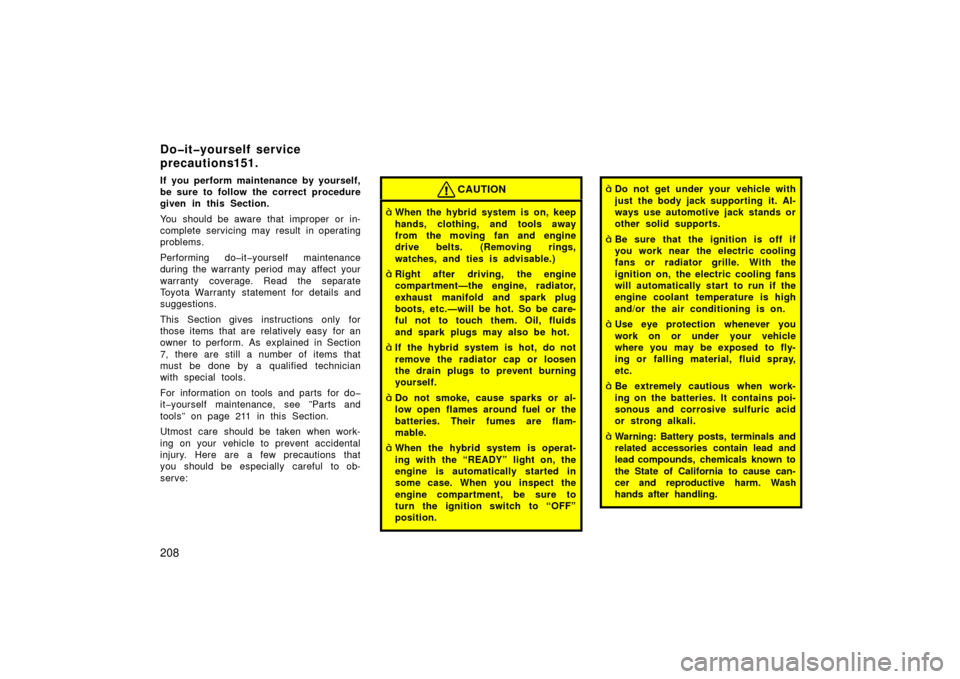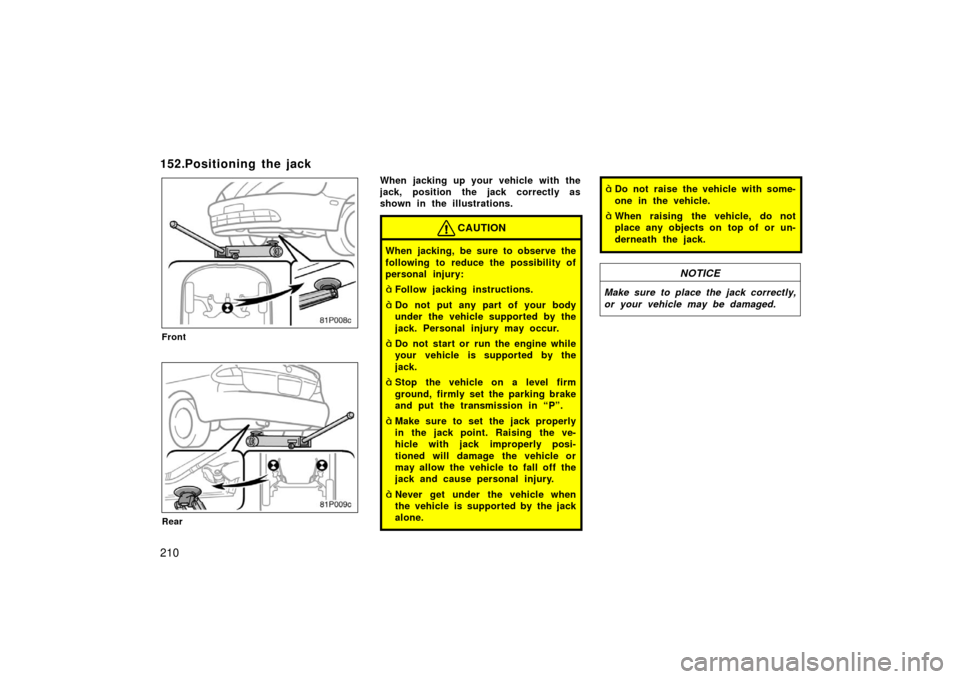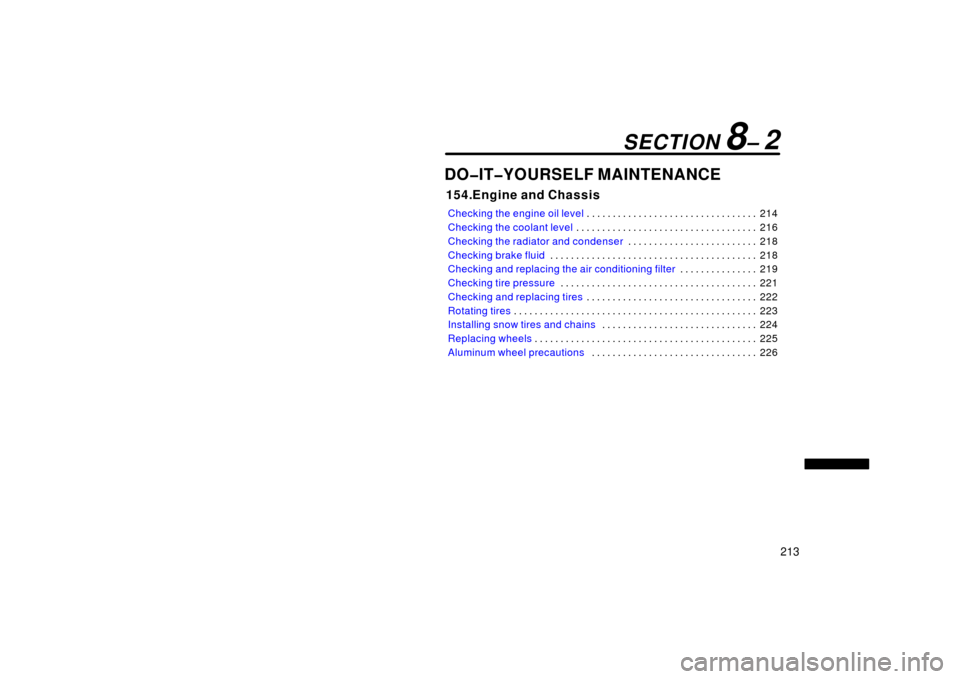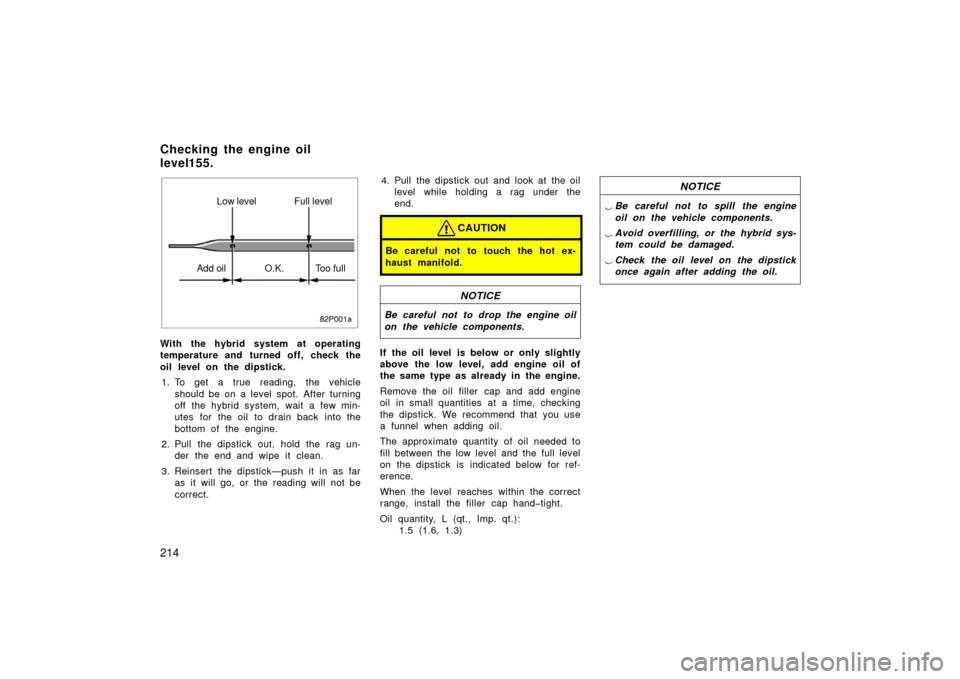Page 212 of 256
206
149.Engine compartment overview
1. Engine coolant reservoir
2. Fuse blocks
3. Brake fluid reservoir
4. Engine oil filler cap
5. Inverter reservoir tank
6. Windshield washer fluid tank
7. Radiator and condenser
8. Engine oil level dipstick
9. Auxiliary battery
81p001f
Page 214 of 256

208
If you perform maintenance by yourself,
be sure to follow the correct procedure
given in this Section.
You should be aware that improper or in-
complete servicing may result in operating
problems.
Performing do�it�yourself maintenance
during the warranty period may affect your
warranty coverage. Read the separate
Toyota Warranty statement for details and
suggestions.
This Section gives instructions only for
those items that are relatively easy for an
owner to perform. As explained in Section
7, there are still a number of items that
must be done by a qualified technician
with special tools.
For information on tools and parts for do�
it�yourself maintenance, see ”Parts and
tools” on page 211 in this Section.
Utmost care should be taken when work-
ing on your vehicle to prevent accidental
injury. Here are a few precautions that
you should be especially careful to ob-
serve:CAUTION
�When the hybrid system is on, keep
hands, clothing, and tools away
from the moving fan and engine
drive belts. (Removing rings,
watches, and ties is advisable.)
�Right after driving, the engine
compartment—the engine, radiator,
exhaust manifold and spark plug
boots, etc.—will be hot. So be care-
ful not to touch them. Oil, fluids
and spark plugs may also be hot.
�If the hybrid system is hot, do not
remove the radiator cap or loosen
the drain plugs to prevent burning
yourself.
�Do not smoke, cause sparks or al-
low open flames around fuel or the
batteries. Their fumes are flam-
mable.
�When the hybrid system is operat-
ing with the “READY” light on, the
engine is automatically started in
some case. When you inspect the
engine compartment, be sure to
turn the ignition switch to “OFF”
position.
�Do not get under your vehicle with
just the body jack supporting it. Al-
ways use automotive jack stands or
other solid supports.
�Be sure that the ignition is off if
you work near the electric cooling
fans or radiator grille. With the
ignition on, the electric cooling fans
will automatically start to run if the
engine coolant temperature is high
and/or the air conditioning is on.
�Use eye protection whenever you
work on or under your vehicle
where you may be exposed to fly-
ing or falling material, fluid spray,
etc.
�Be extremely cautious when work-
ing on the batteries. It contains poi-
sonous and corrosive sulfuric acid
or strong alkali.
�Warning: Battery posts, terminals and
related accessories contain lead and
lead compounds, chemicals known to
the State of California to cause can-
cer and reproductive harm. Wash
hands after handling.
Do�it�yourself service
precautions151.
Page 215 of 256

209
�Used engine oil contains potentially
harmful contaminants which may
cause skin disorders such as in-
flammation or skin cancer, so care
should be taken to avoid prolonged
and repeated contact with it. To re-
move used engine oil from your
skin, wash thoroughly with soap
and water.
�Do not leave used oil within the
reach of children.
�Dispose of used oil and filter only
in a safe and acceptable manner.
Do not dispose of used oil and fil-
ter in household trash, in sewers or
onto the ground. Call your dealer
for information concerning recycling
or disposal.
�Take care when filling the brake
fluid reservoir because brake fluid
can harm your eyes and damage
painted surfaces. If fluid gets in
your eyes, flush your eyes with
clean water immediately. If you still
feel uncomfortable with your eyes,
go to the doctor.
NOTICE
�Remember that batteries and igni-
tion cable carry high currents or
voltages. Be careful of accidentally
causing a short circuit.
� Add only demineralized or distilled
water to fill the radiator. And if you
spill some of the coolant, be sure
to wash it off with water to prevent
it from damaging the parts or paint.
� Do not allow dirt or anything else
to fall through the spark plug holes.
� Do not pry the outer electrode of
spark plug against the center elec-
trode.
� Use only spark plugs of the speci-
fied type. Using other types will
cause engine damage, loss of per-
formance or radio noise.
� If you spill the fluid, be sure to
wash it off with water to prevent it
from damaging the parts or paint.
� Do not drive with the air cleaner
filter removed, or excessive engine
wear could result. Also backfiring
could cause a fire in the engine
compartment.
�Be careful not to scratch the glass
surface with the wiper frame.
� When closing the hood, check to
see that you have not forgotten any
tools, rags, etc.
Page 216 of 256

210
152.Positioning the jack
81p008c
Front
81p009c
Rear
When jacking up your vehicle with the
jack, position the jack correctly as
shown in the illustrations.
CAUTION
When jacking, be sure to observe the
following to reduce the possibility of
personal injury:
�Follow jacking instructions.
�Do not put any part of your body
under the vehicle supported by the
jack. Personal injury may occur.
�Do not start or run the engine while
your vehicle is supported by the
jack.
�Stop the vehicle on a level firm
ground, firmly set the parking brake
and put the transmission in “P”.
�Make sure to set the jack properly
in the jack point. Raising the ve-
hicle with jack improperly posi-
tioned will damage the vehicle or
may allow the vehicle to fall off the
jack and cause personal injury.
�Never get under the vehicle when
the vehicle is supported by the jack
alone.
�Do not raise the vehicle with some-
one in the vehicle.
�When raising the vehicle, do not
place any objects on top of or un-
derneath the jack.
NOTICE
Make sure to place the jack correctly,
or your vehicle may be damaged.
Page 217 of 256

211
153.Parts and tools
Here is a list of parts and tools you will
need on performing do�it�yourself mainte-
nance. Remember all Toyota parts are de-
signed in metric sizes, so your tools must
be metric.
CHECKING THE ENGINE OIL LEVEL
Parts (if level is low):
�Engine oil API grade SL “Energy�Con-
serving” or ILSAC multigrade having
viscosity proper for your climate
Tools:
�Rag or paper towel
�Funnel (only for adding oil)
CHECKING THE COOLANT LEVEL
Parts (if level is low):
�”Toyota Genuine Long Life Coolant” or
equivalent
See page 217 in Section 8�2 for de-
tails about coolant type selection.
�Demineralized or distilled water
Tools:
�Funnel (only for adding coolant) CHECKING BRAKE FLUID
Parts (if level is low):
�SAE J1703 or FMVSS No.116 DOT 3
brake fluid
Tools:
�Rag or paper towel
�Funnel (only for adding fluid)
CHECKING AUXILIARY BATTERY CON-
DITION
Tools:
�Warm water
�Baking soda
�Grease
�Conventional wrench (for terminal
clamp bolts)
CHECKING AND REPLACING FUSES
Parts (if replacement is necessary):
�Fuse with same amperage rating as
original
ADDING WASHER FLUID
Parts:
�Water
�Washer fluid containing antifreeze (for
winter use) Tools:
�Funnel
REPLACING LIGHT BULBS
Parts:
�Bulb with same number and wattage
rating as original (See charts in ”Re-
placing light bulbs–” on page 231 in
Section 8�3.)
Tools:
�Screwdriver
Page 219 of 256

213
DO�IT�YOURSELF MAINTENANCE
154.Engine and Chassis
Checking the engine oil level214
. . . . . . . . . . . . . . . . . . . . . . . . . . . . . . . . .
Checking the coolant level 216
. . . . . . . . . . . . . . . . . . . . . . . . . . . . . . . . . . .
Checking the radiator and condenser 218
. . . . . . . . . . . . . . . . . . . . . . . . .
Checking brake fluid 218
. . . . . . . . . . . . . . . . . . . . . . . . . . . . . . . . . . . . \
. . . .
Checking and replacing the air conditioning filter 219
. . . . . . . . . . . . . . .
Checking tire pressure 221
. . . . . . . . . . . . . . . . . . . . . . . . . . . . . . . . . . . . \
. .
Checking and replacing tires 222
. . . . . . . . . . . . . . . . . . . . . . . . . . . . . . . . .
Rotating tires 223
. . . . . . . . . . . . . . . . . . . . . . . . . . . . . . . . . . . . \
. . . . . . . . . . .
Installing snow tires and chains 224
. . . . . . . . . . . . . . . . . . . . . . . . . . . . . .
Replacing wheels 225
. . . . . . . . . . . . . . . . . . . . . . . . . . . . . . . . . . . . \
. . . . . . .
Aluminum wheel precautions 226
. . . . . . . . . . . . . . . . . . . . . . . . . . . . . . . .
SECTION 8– 2
Page 220 of 256

214
82p001a
Low level Full level
Add oil O.K. Too full
With the hybrid system at operating
temperature and turned off, check the
oil level on the dipstick. 1. To get a true reading, the vehicle should be on a level spot. After turning
off the hybrid system, wait a few min-
utes for the oil to drain back into the
bottom of the engine.
2. Pull the dipstick out, hold the rag un- der the end and wipe it clean.
3. Reinsert the dipstick—push it in as far as it will go, or the reading will not be
correct. 4. Pull the dipstick out and look at the oil
level while holding a rag under the
end.
CAUTION
Be careful not to touch the hot ex-
haust manifold.
NOTICE
Be careful not to drop the engine oil
on the vehicle components.
If the oil level is below or only slightly
above the low level, add engine oil of
the same type as already in the engine.
Remove the oil filler cap and add engine
oil in small quantities at a time, checking
the dipstick. We recommend that you use
a funnel when adding oil.
The approximate quantity of oil needed to
fill between the low level and the full level
on the dipstick is indicated below for ref-
erence.
When the level reaches within the correct
range, install the f iller cap hand�tight.
Oil quantity, L (qt., Imp. qt.): 1.5 (1.6, 1.3)
NOTICE
�Be careful not to spill the engine
oil on the vehicle components.
� Avoid overfilling, or the hybrid sys-
tem could be damaged.
� Check the oil level on the dipstick
once again after adding the oil.
Checking the engine oil
level155.
Page 221 of 256
215
156.ENGINE OIL SELECTION
“Toyota Genuine Motor Oil” is filled in
your Toyota vehicle. Use Toyota approved
“Toyota Genuine Motor Oil” or equivalent
to satisfy the following grade and viscos-
ity.
Oil grade:
API grade SL “Energy�Conserving” or
ILSAC multigrade engine oil.
Recommended viscosity:
SAE 5W�30
oil008
Temperature range anticipated before next
oil change
SAE 5W�30 is the best choice, for good
fuel economy, and good starting in cold
weather. If SAE 5W�30 oil is not available, SAE
10W�30 oil may be used. However, it
should be replaced with SAE 5W�30 at
the next oil change.
82P103
API service symbol
ILSAC certification mark